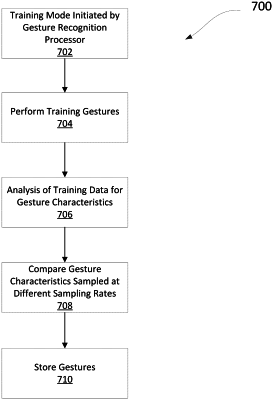| CPC G06F 3/017 (2013.01) [G06F 1/163 (2013.01); G06F 1/3231 (2013.01); G06F 3/011 (2013.01); G06F 3/014 (2013.01); G06V 10/147 (2022.01); G06V 40/23 (2022.01); G09B 19/0038 (2013.01); G16H 20/30 (2018.01)] | 20 Claims |

|
1. A method comprising:
causing, by a device comprising a processor, gesture training to recognize a gesture, wherein the gesture training comprises:
sampling, at a plurality of different sampling rates, first raw sensor data associated with performance of a training gesture;
identifying, from the sampled first raw sensor data, one or more characteristics of the training gesture;
identifying, from the sampled first raw sensor data, a sampling rate, of the plurality of different sampling rates, that is lower than an upper sampling rate, of the plurality of different sampling rates, and at which the one or more characteristics of the training gesture are recognized as if sampled at the upper sampling rate; and
storing the one or more characteristics of the training gesture as a gesture sample for a first gesture and storing the lower sampling rate together with the gesture sample, wherein the stored gesture sample is one of a plurality of stored gesture samples;
recognizing, from a first portion of second raw sensor data, that the device is in proximity to a beacon;
recognizing, from a second portion of the second raw sensor data and based on comparing one or more characteristics of the second portion to the plurality of stored gesture samples, the first gesture; and
causing, based on the proximity to the beacon and the first gesture, the device to sample data at the lower sampling rate.
|